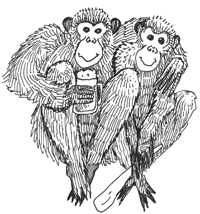STRANGEBUTTRUE- Forgotten shadows: The animal that acts like us

DRAWING BY DEBORAH DERR McCLINTOCK
Q. What other animal walks on two feet (some of the time), gets b.o. when nervous, "kisses butt" to show submission, makes and uses tools, adopts orphaned babies, holds grudges and nurses resentments, plans for the future, experiences prolonged grief, gets AIDS, becomes wrinkled and gray with age, learns languages, recognizes itself in the mirror, shares food with friends and relatives and, if given the opportunity, will get drunk. –G. Bush
A. A chimpanzee, as described by Carl Sagan and Ann Druyan in Shadows of Forgotten Ancestors.
Q. Why do we humans live 75 years or so when our fellow mammals check out much earlier? –G. M. Moses
A. Life-spans are puzzling: Mice live about three years, cats and dogs about a dozen. And elephants, in spite of lugging around several tons more than a mouse, cat or dog, live to a ripe old 35 or more.
You begin to solve the puzzle, says Stephen Jay Gould in The Panda's Thumb, when you realize all mammals except Homo sapiens are good only for about 800 million heartbeats, 200 million breaths. Smaller animals, which lose heat much faster, need higher metabolisms (faster pulses, faster respiration) to stay warm, so they burn down their candle faster. You can watch your cat or dog breathing comparatively rapidly, its heart racing, its days numbered.
The lucky gift for humankind is that although we use up our 800 million heartbeats by age 25 or so, we go on for yet half a century. For a mammal our size, we live about three times as long as we "should," perhaps because of our species' long gestation period and extended childhood.
Q. The professor painstakingly trained scores of rats to run a maze, then cut out pieces of their cortex before retesting this ability. What was he trying to prove? –A.M. Nesia
A. In Arthur Conan Doyle's A Study in Scarlet, Sherlock Holmes offered a popular theory of memory capacity: "I consider that a man's brain originally is like a little empty attic, and you have to stock it with such furniture as you choose... Depend upon it, there comes a time when for every addition of knowledge, you forget something that you knew before."
Now to the rat studies: Amazingly, no matter what small brain section psychologist Karl Lashley removed, the rats retained at least partial memory of how to navigate the maze, says David G. Myers in Psychology.
This demonstrated that memories are not stored in single, specific spots of the brain but rather are spread throughout holistically. Contrary to Holmes's belief, our brains are not like cluttered attics, which once filled can store more items only if we discard old ones. Rather, our capacity for storing long-term memories is vast and at times even phenomenal.
Q. In an Age of AIDS and Hepatitis B, aren't dead bodies pathogenic "bombs" threatening the funeral industry? –D. Aller
A. Fears are great, says Kenneth V. Iserson in Death to Dust, but public health statistics show no elevated AIDS risk among embalmers, and only 13 percent greater Hepatitis B incidence, even though they are exposed to the virus twice as often as the general public. The numbers could be improved further if more workers followed the "universal precautions" of gloves, masks, waterproof gowns and eye coverings and got Hepatitis B immunization.
"Dead bodies present fewer risks to the living than do other people," said a San Francisco General Hospital former Chief of Pathology. "There are several advantages to being dead....You don't excrete, inhale, exhale, perspire."
Q. In its portrayal of gun silencers, does Hollywood more deserve an "A" for accurate or an "F" for fictitious? – D. Harry
A. Foremost "F"iction is that the silencer market has been cornered by the James Bondesque underworld when it's really more sportsmen, law enforcement and the military.
For you uninitiated, take a shot: How can an explosive BAM! that can damage hearing be tamed into the little FFFT you see in the movies? The silencer screws onto the end of the barrel and has huge volume for the propellent gas to expand into, 20-30 times bigger than the barrel, says Marshall Brain's How Stuff Works. So when the bullet finally exits through the hole in the silencer, it's like uncorking a bottle at 60 PSI instead of 3,000 PSI.
But don't believe the FFFT of Hollywood, says New Scientist magazine. "Real designs are more likely to produce a muffled crack, or to sound like a car door being slammed," the journal notes. Plus, the real things are much larger than the celluloid cigar-tube-sized variety, and tougher to fit on.
The deadliness shown is accurate in any case, whether for subsonic ammo common with silencers or for supersonic (high-speed), the latter impossible to muffle completely because of the bullet's loud sonic boom issued in flight.
~
Send Strange questions to brothers Bill and Rich at [email protected]
#